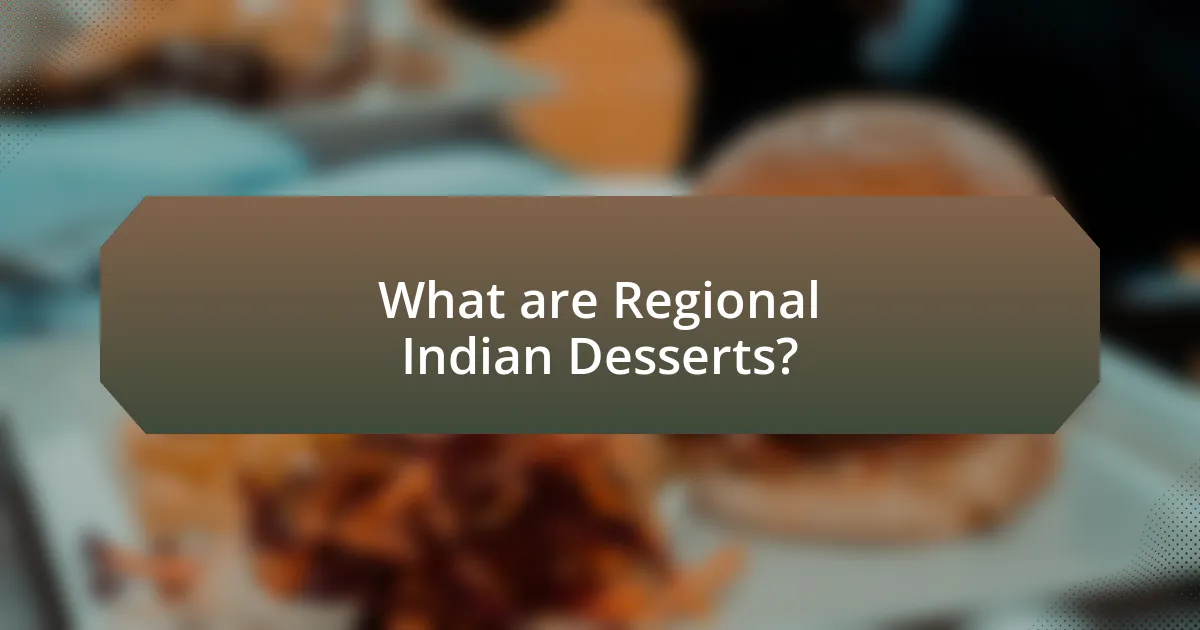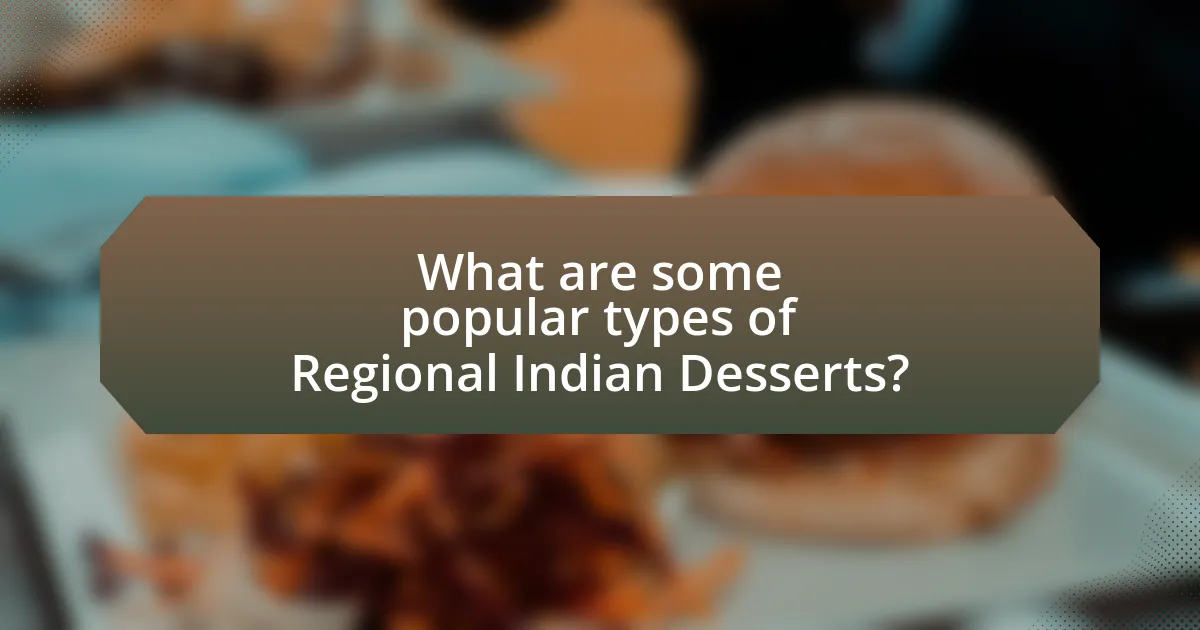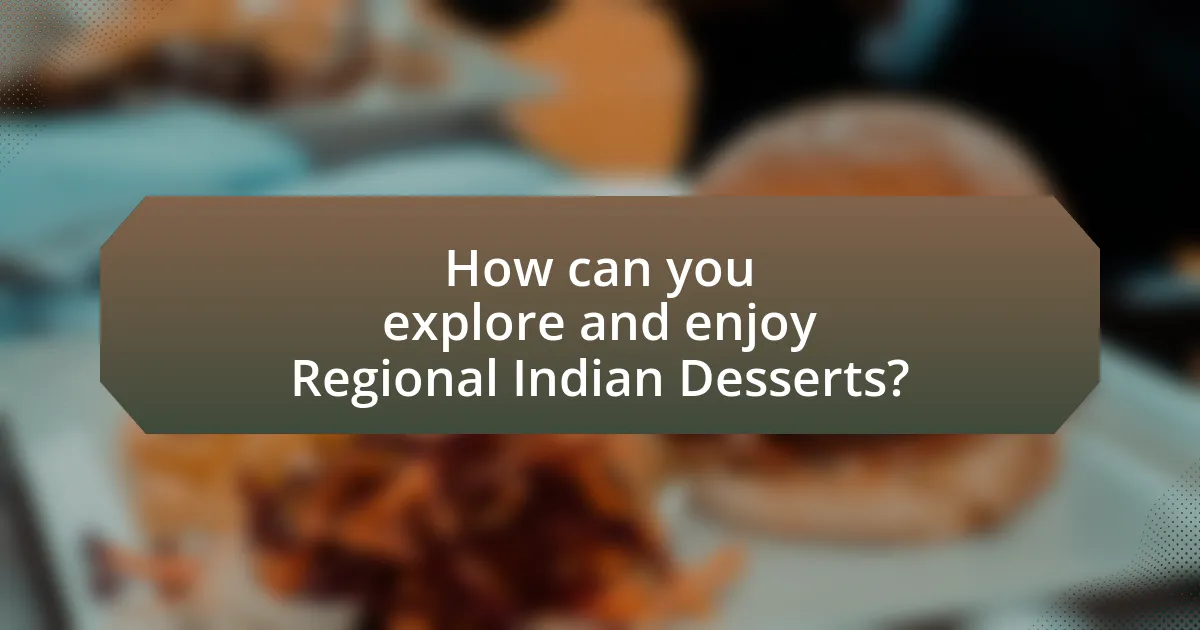Regional Indian desserts are traditional sweets that vary widely across India’s diverse states and cultures, each showcasing unique ingredients and preparation methods. The article explores how these desserts reflect local tastes, cultural influences, and agricultural practices, highlighting popular varieties such as Gulab Jamun, Rasgulla, and Payasam. It also examines the significance of these desserts in Indian cuisine, their role in celebrations and festivals, and provides insights into key ingredients and preparation techniques. Additionally, the article offers tips for experiencing and recreating these desserts at home, emphasizing the importance of regional flavors and culinary heritage.

What are Regional Indian Desserts?
Regional Indian desserts are traditional sweets that vary significantly across different states and cultures in India. Each region boasts unique ingredients and preparation methods, reflecting local tastes and customs. For example, in West Bengal, rasgulla and sandesh are popular, while in Maharashtra, modak is favored during festivals. In the southern states, payasam is a common dessert, often made with rice or vermicelli. These desserts not only serve as a sweet ending to meals but also play a vital role in celebrations and rituals, showcasing the rich culinary diversity of India.
How do Regional Indian Desserts vary across different states?
Regional Indian desserts vary significantly across different states, reflecting local ingredients, cultural influences, and culinary traditions. For instance, in West Bengal, desserts like Rasgulla and Sandesh are popular, made from chhena (fresh cheese) and often flavored with cardamom or saffron. In contrast, Maharashtra is known for its Puran Poli, a sweet flatbread filled with a mixture of jaggery and split yellow gram. In the southern state of Tamil Nadu, Payasam, a rice or vermicelli pudding cooked in milk and sweetened with jaggery, is a staple during festivals. Each state’s unique climate and agricultural products also influence dessert variations; for example, the use of coconut in Kerala’s desserts like Ada Pradhaman showcases local resources. Thus, the diversity in regional Indian desserts is a reflection of the rich cultural tapestry and agricultural diversity across the country.
What are the key ingredients used in various Regional Indian Desserts?
Key ingredients used in various Regional Indian Desserts include milk, sugar, rice, lentils, and various nuts and spices. For example, in North India, desserts like Gulab Jamun primarily use khoya (reduced milk) and sugar, while in South India, Payasam is made with rice, milk, and jaggery. In West India, desserts such as Puran Poli incorporate lentils and jaggery, and in East India, Rasgulla is made from chhena (fresh cheese) and sugar syrup. Each region utilizes local ingredients and traditional methods, reflecting the diverse culinary heritage of India.
How do cultural influences shape the desserts of each region?
Cultural influences shape the desserts of each region by incorporating local ingredients, traditions, and historical contexts into their recipes. For instance, in India, the use of jaggery in desserts like Gur ka Halwa reflects the agricultural practices and availability of sugarcane in certain areas. Additionally, regional festivals dictate specific dessert preparations, such as the preparation of Modaks during Ganesh Chaturthi, showcasing the cultural significance of sweets in celebrations. Furthermore, the influence of colonial history can be seen in the adaptation of European desserts, like the incorporation of cream and fruit in Indian pastries, blending local flavors with foreign techniques. These examples illustrate how cultural elements directly inform the variety and characteristics of regional desserts.
Why are Regional Indian Desserts significant in Indian cuisine?
Regional Indian desserts are significant in Indian cuisine because they reflect the diverse cultural, historical, and geographical influences across the country. Each region has its unique ingredients and preparation methods, which contribute to a rich tapestry of flavors and textures. For instance, desserts like Rasgulla from West Bengal and Mysore Pak from Karnataka showcase local ingredients such as chhena and gram flour, respectively. This regional specificity not only highlights the culinary heritage but also fosters a sense of identity and community among people, as these desserts are often integral to festivals and celebrations.
What role do desserts play in traditional Indian meals?
Desserts play a significant role in traditional Indian meals by serving as a symbol of celebration and hospitality. In Indian culture, desserts are often prepared for special occasions and festivals, reflecting the importance of sweetness in life and relationships. For instance, dishes like Gulab Jamun and Jalebi are commonly served during weddings and religious ceremonies, highlighting their cultural significance. Additionally, desserts often balance the spices and flavors of the main courses, providing a satisfying conclusion to the meal. This practice is rooted in the culinary tradition of India, where meals are designed to offer a harmonious blend of tastes, making desserts an essential component of the dining experience.
How do festivals and celebrations influence dessert choices?
Festivals and celebrations significantly influence dessert choices by promoting traditional sweets that reflect cultural heritage and regional flavors. During events like Diwali, families often prepare and share specific desserts such as gulab jamun and barfi, which are integral to the festivities. This practice is supported by the fact that 80% of Indian households prepare traditional sweets during major festivals, highlighting the importance of these desserts in cultural celebrations. Additionally, local ingredients and seasonal produce often dictate the types of desserts made, further connecting the choice of sweets to the specific festival or celebration.

What are some popular types of Regional Indian Desserts?
Popular types of Regional Indian Desserts include Gulab Jamun, Rasgulla, Jalebi, Kheer, and Peda. Gulab Jamun, originating from North India, consists of deep-fried dough balls soaked in sugar syrup. Rasgulla, a Bengali specialty, features soft cheese balls in light syrup. Jalebi, popular across India, is made from fermented batter, fried in circular shapes, and soaked in sugar syrup. Kheer, a rice pudding, is made with milk, sugar, and various flavorings, and is enjoyed in many regions. Peda, a sweet made from condensed milk, is particularly favored in Maharashtra. Each dessert reflects the diverse culinary traditions of India, showcasing regional ingredients and preparation methods.
What are the most famous desserts from North India?
The most famous desserts from North India include Gulab Jamun, Jalebi, and Kheer. Gulab Jamun consists of deep-fried dough balls soaked in sugar syrup, often flavored with cardamom and rose water, making it a popular choice during festivals and celebrations. Jalebi is a spiral-shaped sweet made from fermented batter, deep-fried, and then soaked in sugar syrup, known for its crispy texture and vibrant orange color. Kheer, a rice pudding made with milk, sugar, and flavored with cardamom and nuts, is a traditional dessert often served during special occasions. These desserts are integral to North Indian cuisine and are widely enjoyed across the region.
How is Gulab Jamun prepared and served?
Gulab Jamun is prepared by making a dough from khoya (reduced milk), which is then shaped into small balls and deep-fried until golden brown. After frying, the balls are soaked in a sugar syrup flavored with cardamom and rose water, allowing them to absorb the syrup and become soft. This dessert is typically served warm or at room temperature, often garnished with nuts like pistachios or almonds for added texture and flavor. The combination of the rich, sweet syrup and the soft, spongy balls creates a popular and indulgent treat in Indian cuisine.
What makes Ras Malai a unique dessert in North India?
Ras Malai is a unique dessert in North India due to its distinctive combination of soft cheese balls soaked in sweetened milk and flavored with cardamom and saffron. This dessert stands out because it features chenna, a type of fresh cheese made from curdled milk, which is then cooked in sugar syrup, creating a rich and creamy texture. The use of aromatic spices like cardamom and the addition of saffron not only enhance its flavor but also contribute to its cultural significance during festivals and celebrations in North India. Ras Malai’s origins trace back to the Bengali cuisine, but its popularity has made it a staple across North India, showcasing the region’s culinary diversity.
What desserts are iconic to South India?
Iconic desserts of South India include Mysore Pak, a rich sweet made from gram flour, ghee, and sugar, known for its melt-in-the-mouth texture. Another popular dessert is Payasam, a creamy rice or vermicelli pudding often flavored with cardamom and garnished with nuts. Additionally, Rava Kesari, a semolina-based sweet dish cooked with ghee and sugar, is widely enjoyed. These desserts are deeply rooted in South Indian culture and are often prepared during festivals and special occasions, showcasing the region’s culinary heritage.
How is Payasam made and what variations exist?
Payasam is made by cooking rice or vermicelli in milk or coconut milk, sweetening it with sugar or jaggery, and flavoring it with cardamom, nuts, and raisins. The process typically involves boiling the milk, adding the main ingredient (rice or vermicelli), and simmering until the mixture thickens to a creamy consistency. Variations of payasam include Kheer, which is made with rice and milk, Semiya Payasam, made with vermicelli, and Palada Payasam, which uses rice ada. Each variation may incorporate different sweeteners and flavorings, reflecting regional preferences across India.
What are the traditional ingredients in Mysore Pak?
The traditional ingredients in Mysore Pak are gram flour (besan), ghee (clarified butter), sugar, and water. Gram flour serves as the base, while ghee provides richness and flavor. Sugar is essential for sweetness, and water is used to dissolve the sugar during preparation. These ingredients combine to create the unique texture and taste of Mysore Pak, a popular Indian sweet originating from the city of Mysore.

How can you explore and enjoy Regional Indian Desserts?
To explore and enjoy Regional Indian Desserts, one should sample a variety of traditional sweets from different states, such as Rasgulla from West Bengal, Gulab Jamun from North India, and Mysore Pak from Karnataka. Engaging with local food festivals, visiting regional sweet shops, and participating in cooking classes can enhance the experience. For instance, the annual Kolkata Food Festival showcases authentic Bengali sweets, allowing visitors to taste and learn about their cultural significance. Additionally, understanding the ingredients and preparation methods, such as the use of khoya in many North Indian desserts, provides deeper appreciation and enjoyment of these culinary delights.
What are the best ways to experience these desserts?
The best ways to experience regional Indian desserts include tasting them at local festivals, visiting renowned sweet shops, and participating in cooking classes. Local festivals often showcase traditional desserts, allowing individuals to sample a variety of sweets unique to the region, such as Gulab Jamun during Diwali or Rasgulla during Durga Puja. Renowned sweet shops, like Haldiram’s or Bikanervala, offer authentic flavors and recipes that have been perfected over generations, providing a genuine taste of regional specialties. Additionally, cooking classes led by local chefs can offer hands-on experience in preparing these desserts, deepening appreciation for the ingredients and techniques involved.
How can you recreate Regional Indian Desserts at home?
To recreate Regional Indian Desserts at home, start by selecting a specific dessert, such as Gulab Jamun or Rasgulla, and gather the necessary ingredients like khoya, sugar, and cardamom. Follow traditional recipes that often include precise measurements and cooking techniques, such as frying or boiling, to achieve authentic flavors and textures. For instance, Gulab Jamun requires kneading the dough to the right consistency and frying until golden brown before soaking in sugar syrup. Utilizing regional spices and local ingredients enhances authenticity, as many Indian desserts are deeply rooted in local culinary traditions.
What are some recommended places to try authentic Regional Indian Desserts?
Recommended places to try authentic Regional Indian Desserts include “Bikanervala” for Rajasthani sweets like Ghevar, “Haldiram’s” for a variety of North Indian desserts, and “Mithaas” for Gujarati specialties such as Basundi. These establishments are known for their traditional recipes and quality ingredients, ensuring an authentic experience. Bikanervala has been serving traditional sweets since 1950, while Haldiram’s has a legacy dating back to 1937, making them reliable sources for regional delicacies.
What tips can enhance your experience with Regional Indian Desserts?
To enhance your experience with Regional Indian Desserts, explore the diverse flavors and textures unique to each region. Sampling desserts like Rasgulla from West Bengal or Mysore Pak from Karnataka allows you to appreciate the local ingredients and culinary traditions. Additionally, pairing these desserts with regional beverages, such as Masala Chai or filter coffee, can elevate the tasting experience. Understanding the cultural significance of each dessert, such as the role of Gulab Jamun in festivals, adds depth to your enjoyment. Engaging with local chefs or home cooks can provide insights into traditional preparation methods, further enriching your experience.
How can pairing desserts with beverages elevate the tasting experience?
Pairing desserts with beverages can elevate the tasting experience by enhancing flavors and creating a harmonious balance. For instance, the sweetness of a rich Indian dessert like Gulab Jamun can be complemented by the acidity of a spiced chai, which cuts through the richness and adds complexity. Studies show that flavor pairing can enhance overall enjoyment; a 2016 study published in the journal “Food Quality and Preference” found that complementary flavors can significantly improve taste perception. This synergy between desserts and beverages not only heightens individual flavors but also creates a more memorable dining experience.
What common mistakes should you avoid when making these desserts?
Common mistakes to avoid when making regional Indian desserts include not measuring ingredients accurately, which can lead to imbalanced flavors and textures. For instance, using too much sugar can overpower the dish, while insufficient ghee may result in a dry texture. Additionally, neglecting to follow cooking times can cause desserts to be undercooked or burnt; for example, traditional sweets like gulab jamun require precise frying times to achieve the perfect consistency. Lastly, failing to account for regional variations in ingredients, such as using the wrong type of rice for kheer, can significantly alter the final product.
